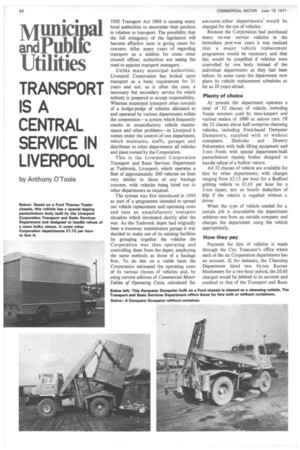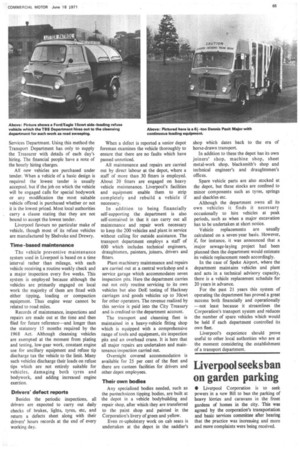munici al
Page 66

Page 67

If you've noticed an error in this article please click here to report it so we can fix it.
and Pub c
Utilities
TRANSPORT IS A CENTRAL SERVICE IN LIVERPOOL
by Anthony O'Toole
Below: Baited on a Ford Themes Trader chassis, this vehicle has a special tipping pantechnicon body built by the Liverpool Corporation Transport and Basic Services Department and designed to handle refuse of a more bulky nature. It costs other Corporation departments E1.72 per hour to hire it.
THE Transport Act 1968 is causing many local authorities to reconsider their position in relation to transport. The possibility that the full stringency of the legislation will become effective soon is giving cause for concern. After many years •of regarding transport as a sideline for some other council officer, authorities are seeing the need to appoint transport managers.
Unlike many municipal authorities, Liverpool Corporation has looked upon transport as a basic requirement for 21 years and not, as is often the case, a necessary but secondary service for which nobody is prepared to accept responsibility. Whereas municipal transport often consists of a hodge-podge of vehicles allocated to and operated by various departments within the corporation—a system which frequently results in unsatisfactory vehicle maintenance and other problems—in Liverpool it comes under the control of one department, which maintains, staffs, garages and distributes to other departments all vehicles and plant owned by the Corporation.
This is the Liverpool Corporation Transport and Basic Services Department at Tuebrook, Liverpool, which operates a fleet of approximately 200 vehicles on lines very similar to those of any haulage concern, with vehicles being hired out to other departments as required.
The system was first introduced in 1950 as part of a programme intended to spread out vehicle replacement and operating costs and ease an unsatisfactory transport situation which developed shortly after the war. As the Tuebrook depot had originally been a tramway maintenance garage it was decided to make use of its existing facilities by grouping together the vehicles the Corporation was then operating and controlling them from the depot, employing the same methods as those of a haulage firm. To do this on a viable basis the Corporation estimated the operating costs of its various classes of vehicles and, by using current editions of Commercial Motor Tables of Operating Costs, calculated the amounts other departments' would be charged for the use of vehicles.
Because the Corporation had purchased many ex-war service vehicles in the immediate post-war years it was realized that -a major vehicle replacement programme would be necessary and that this would be simplified if vehicles were controlled by one body instead of the individual departments as they had been before. In some cases the department now plans its vehicle replacement schedules as far as 20 years ahead.
Plenty of choice At present the department operates a total of 32 classes of vehicle, including Vespa scooters used by time-keepers and various makes of 1000 cc saloon cars. Of the 32 classes about half comprise cleansing vehicles, including Ford-based Dempster Dumpsters, supplied with or without containers, Shelvoke and Drewry Pakamatics with bulk lifting equipment and 3-ton Fords with special department-built pantechnicon tipping bodies designed to handle refuse of a bulkier nature.
All 32 classes of vehicle are available for hire by other departments, with charges ranging from £3.13 per hour for a Bedford gritting vehicle to £1.65 per hour for a 5-ton tipper, less an hourly deduction of 60p if the vehicle is supplied without a driver.
When the type of vehicle needed for a certain job is unavailable the department subhires one from an outside company and charges the department using the vehicle appropriately.
How they pay Payment for hire of vehicles is made through the City Treasurer's office where each of the six Corporation departments has an account. If, for instance, the Cleansing Department hired two 6fton Karrier Musketeers for a two-hour period, the £8.68 charged would be debited to its account and credited to that of the Transport and Basic Services Department. Using this method the Transport Department has only to supply the Treasurer with details of each day's hiring. The financial people have a note of the hourly hiring charges.
All new vehicles are purchased under tender. When a vehicle of a basic design is required the lowest tender is usually accepted, but if the job on which the vehicle will be engaged calls for special bodywork or any modification the most suitable vehicle offered is purchased whether or not it is the lowest priced. Most local authorities carry a clause stating that they are not bound to accept the lowest tender.
Liverpool favours no particular make of vehicle, though most of its refuse vehicles are manufactured by Shelvoke and Drewry.
Time-based maintenance
The vehicle preventive maintenance system used in Liverpool is based on a time interval rather than mileage, with each vehicle receiving a routine weekly check and a major inspection every five weeks. This system is employed because although the vehicles are primarily engaged on local work the majority of them are fitted with either tipping, loading or compaction equipment. Thus engine wear cannot be related to road miles.
Records of maintenance, inspections and repairs are made out at the time and then filed for future reference—and longer than the statutory 15 months required by the 1968 Act Although cleansing vehicles are exempted at the moment from plating and testing, low-gear work, constant engine use for ancillary equipment and refuse tip discharge tax the vehicle to the limit. Many such vehicles discharge their loads on refuse tips which are not entirely suitable for vehicles, damaging both tyres and bodywork, and adding increased engine exertion.
Drivers' defect reports Besides the periodic inspections, all drivers are expected to carry out daily checks of brakes, lights, tyres, etc, and return a defects sheet along with their drivers' hours records at the end of every working day. When a defect is reported a senior depot foreman examines the vehicle thoroughly to ensure that there are no faults which have passed unnoticed.
All maintenance and repairs are carried out by direct labour at the depot, where a staff of more than 30 fitters is employed. About 20 fitters are engaged on heavy vehicle maintenance. Liverpool's facilities and equipment enable them to strip completely and rebuild a vehicle if necessary.
In addition to being financially self-supporting the department is also self-contained in that it can carry out all maintenance and repair work necessary to keep the 200 vehicles and plant in service without calling for outside assistance. The transport department employs a staff of 600 which includes technical engineers, draughtsmen, painters, joiners, drivers and fitters.
Plant-machinery maintenance and repairs are carried out at a central workshop and a service garage which accommodates seven inspection pits. Here the department carries out not only routine servicing to its own vehicles but also DoE testing of Hackney carriages and goods vehicles up to 30cwt for other operators. The revenue realized by this service is paid into the City Treasury and is credited to the department account.
The transport and cleansing fleet is maintained in a heavy-vehicle fitting shop which is equipped with a comprehensive range of tools and equipment, six inspection pits and an overhead crane. It is here that all major repairs are undertaken and maintenance inspection carried out.
Overnight covered accommodation is available for 25 per cent of the fleet and there are canteen facilities for drivers and other depot employees.
Their own bodies
Any specialized bodies needed, such as the pantechnicon tipping bodies, are built at the depot in a vehicle bodybuilding and repair shop, after which they are transferred to the paint shop and painted in the Corporation's livery of green and yellow.
Even re-upholstery work on cab seats is undertaken at the depot in the saddler's shop which dates back to the era of horse-drawn transport.
In addition to these the depot has its own joiners' shop, machine shop, sheet metal-work shop, blacksmith's shop and technical engineer's and draughtsmen's offices.
Spare vehicle parts are also stocked at the depot, but these stocks are confined to minor components such as tyres, springs and shackles etc.
Although the department owns all its own vehicles it finds it necessary occasionally to hire vehicles at peak periods, such as when a major excavation has to be undertaken at short notice.
Vehicle replacements are usually calculated on a seven-year basis. However, if, for instance, it was announced that a major sewage-laying project had been planned then the department would estimate its vehicle replacement needs accordingly.
In the case of Speke Airport, where the department maintains vehicles and plant and acts in a technical advisory capacity, there is a vehicle replacement schedule for 20 years in advance.
For the past 21 years this system of operating the department has proved a great success both financially and operationally —not least because it streamlines the Corporation's transport system and reduces the number of spare vehicles which would be held if each department controlled its own fleet.
Liverpool's experience should prove useful to other local authorities who are at the moment considering the establishment of a transport department.
































































































































